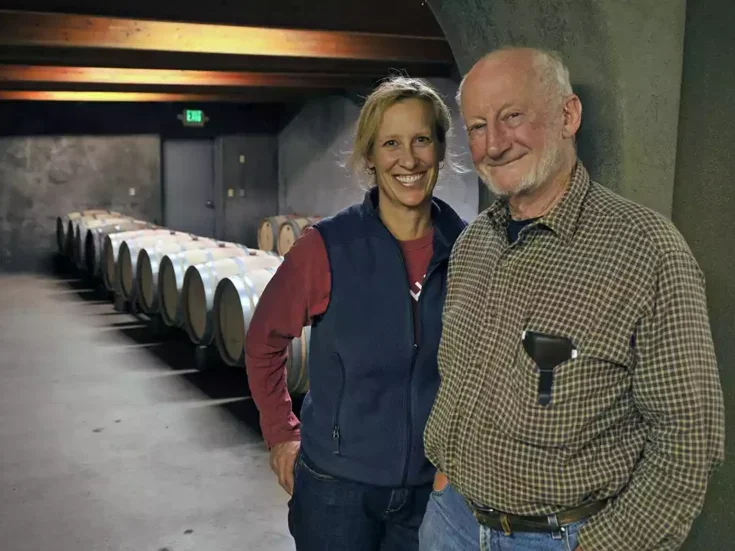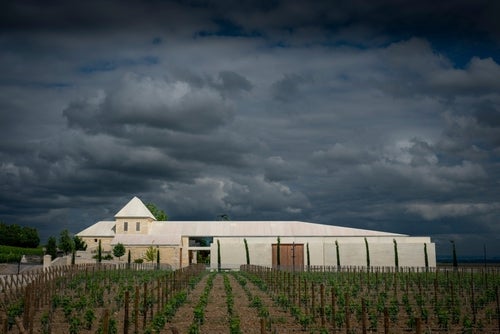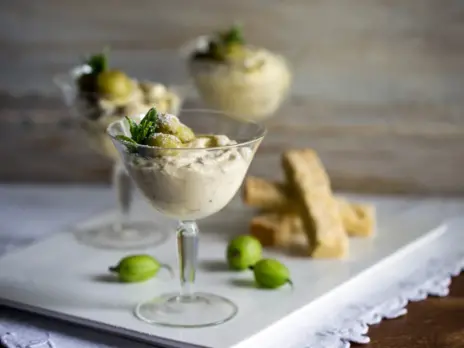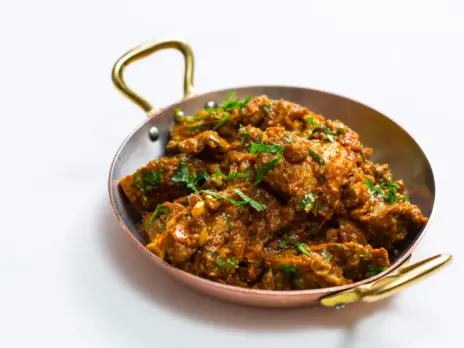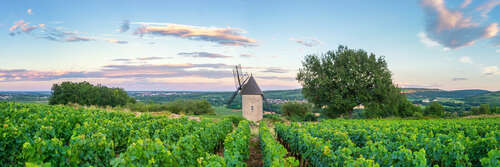
SANTENAY
DOMAINE PHILIPPE LE HARDI
This estate, owned by French bank Crédit Agricole, has increased in quality since Jean-Philippe Archambaud took over the helm in 2019. (The name changed from Château de Santenay to Philippe le Hardi in 2021). It is a large domaine of 98ha (242 acres), which expanded in 2021 with the purchase of a small estate of 5.5ha (13.5 acres) that has been certified organic and biodynamic since 2010. This gave the domaine some Santenay vineyards, which it was lacking, given the location of the château. In 2019, Crédit Agricole had already purchased another 10ha (25-acre) estate in Gevrey. Prior to this, the estate had been purchasing fruit in the Côte de Nuits. Jean-Philippe has made some significant changes in the winery. He commented that 2023 had been a “challenging vintage during the growing season,” adding, “But because we did a green-harvest, I like the results.” He feels it has produced “approachable wine,” finding some comparisons with 2017 and 2011.
Hautes-Côtes de Beaune Les Foires
Soft and generous. Peachy, rounded, and succulent mid-palate, but on the finish, very pithy and piquant. Chalky, tense, and salty at the end. 2025–28. 83
Bourgogne Côte d’Or
This is from the 12ha (30-acre) Sous Les Foires lieu-dit. A citrusy aroma, with herbal notes, very upright. Straighter, edgier, much more mineral and salty. 2025–28. 84
Mercurey La Brigadiers
This was originally planted to Pinot Noir but was replanted 12 years ago to Chardonnay. It is on a north-facing slope at 250m (820ft)—the highest part of Mercurey—and rich in limestone, so it is always picked at the start of the harvest. Super-juicy and succulent. Slightly exotic at the front, yet it has tension and is bright and sappy. 2025–27. 83–84
Mercurey Le Closeau
Spicy, marzipan, toasty aroma. This has a broader and richer palate, with a graphite smokiness from the white soil. 2025–27. 84
Rully Premier Cru
This comes from two east-facing parcels in the upper part of the village. It’s ripe on the strike, yet quite tight, with savory salinity and pithiness on the finish. Late-2025–29. 86–87
Santenay Premier Cru Beaurepaire
Slightly reductive and oaky. Quite full on the mid-palate and flinty to finish. The soil is not so stony, but the palate has a nice, smooth-stone character. Supple and smooth, with a cool note to finish. Late-2025–35. 87–88
Red
Gevrey-Chambertin Champerrier du Dessus
Attractive, bloody aroma and meaty attack. Juicy, rich, and succulent. It tightens to a salty, sapid finish. 2026–32. 88
Gevrey-Chambertin Premier Cru Au Closeau
There are only two producers of wine from this 0.5ha (1.2-acre) climat, probably planted in the 1930s. All of the work here is by hand. It is finer and purer than the Petite Chapelle, with silky tannins, nice intensity, and a sweet and lively finish. 2026–33. 92
Hautes-Côtes de Beaune Les Champs Lambert
From a 0.7ha (1.7-acre) parcel planted in 1995, probably with a mix of clones. Jean-Philippe might switch back to white here. An upright and fresh aroma of garden herbs. It’s fresh, piquant, and sprightly. Delicately done. Fine tannins. Very fruity, with a herbal waft to finish. So pretty. 2025–28. 84
Mercurey Boit de Lalier
From a village parcel very close to those for the following two Mercurey wines. Juicy, rounded, and supple, with generous strawberry fruit. Easy-going, if quite simple. 2025–26. 82–83
Mercurey Les Cheneaults
An aroma of ripe red-currant fruit. The most interesting and most refined of the three village lieu-dit wines. Energetic and bright, with lightly crunchy tannins. 2025–28. 85
Mercurey Les Doués
The soil here is richer in stones than the neighboring lieux-dits. Dark, spicy, and slightly grippy. A little austere, but attractive. 2025–28. 84
Mercurey Premier Cru Les Croichots
From a 1ha (2.47-acre) south-facing parcel. Appealingly rounded on the nose, then silky-smooth on the palate. A lick of oak over some nicely ripe fruit, which is both fresh and concentrated, and carries to a sweet finish. 2025–30. 87
Mercurey Premier Cru Les Puillets
Upright, red-cherry aroma. Bright and splashing upfront, with morello-cherry fruit and freshness, and medium body. The cherry fruit on the finish tastes a little baked and much richer, but I like the evolution. There is cool cut under the palate and crunch to the tannin. Ripe, but more refined than the Croichots. Wraps into a rather appealing package. 2025–30. 87
Santenay Premier Cru Comme
Sweet aroma. Juicy, ripe, and succulent strike. There is good freshness and it finishes on a light and lively line. 2025–30. 86
Santenay Premier Cru Gravières
Spot-on. Plenty of punch and vivacity. Good density and minerality and follow through. 2026–30. 87–88
DOMAINE JESSIAUME
William Waterkeyn, who makes the wines here, remarked on the “important delay between the ripening of the whites and the reds. We started the harvest in August with the whites, then stopped for ten days before restarting with the reds.”
For the whites this year he made a comparison of whole-bunch versus destemmed fruit, also between a regular setting for the press and a Champenois style of press (fewer turns and clearer juice in the end). “I prefer clearer juice—fewer turns—and I do not exceed 1 bar of pressure. We may lose a bit of juice, but not that much, and I prefer the clean taste of the juice this way.” Finally, he blind-tasted the wines and found he always preferred those made with the Champenois press. “I also had a slight preference for the destemmed fruit. For sure, I’ll stick with the Champenois way of pressing in the future, but I’m not sure about the destemmed fruit versus whole bunches.” He added, “I’ve never tried to do a real foulage crush of the grapes prior to press.
“We do a very quick débourbage before filling the barrels.” He didn’t adjust the acidity but chaptalized some wines by 0.5% ABV. The whites are aged 12 months in oak (light toast and up to one third new oak for the premier crus), spend between four and six months in stainless-steel tanks or barrels. He describes the whites as “Balanced wines, not very fresh but not too heavy either. The aromas are really interesting, and I think the wines will evolve and age very well. They remind me of the 2018s, but are better balanced and more concentrated.”
The reds were sorted for unripe berries and all destemmed. William describes them as “Elegant, accessible wines, with bright, fresh red fruits. The tannins are soft and silky. The vintage is more approachable than 2022 for the reds but may not be so long-lived. It’s a little like 2019 but not as concentrated. And a little like 2015, but the tannins are softer.”
I really liked the Santenay and the Auxey-Duresses that I tasted but wasn’t quite so keen on the Beaune, which seemed to me a bit overripe.
White
Auxey-Duresses Premier Cru Les Ecussaux
I believe Jessiaume is the only producer of white wine from Ecussaux. “It’s a real argilo-calcaire [clay-limestone] soil and it suits Chardonnay very well,” said William. A citrus and floral aroma to the peachy and rounded palate. Good intensity to this alluring, lightly creamy Auxey, which finishes with a hint of lemon zest. 2025–28. 87
Santenay Premier Cru Les Gravières
Lightly roasted almonds on the nose. A ripe strike to the savory, punchy palate, underscored with a slightly stony bitterness carrying to a pithy finish. 2026–30. 88
Red
Santenay La Cassière
From a parcel in the middle of Santenay, just below La Maladière, on a southeast-facing slope, with quite thin, sandy soil. Ripe, cherry aroma to a tarter, sappy, morello-cherry palate, which has zesty, tannic crunchiness. Ripe but lively and bright, crisp and snappy on the finish. A bit tart but in a good way. Late-2025–28. 86–87
Santenay Premier Cru Les Gravières
A juicy, upright, red-berry aroma, then this springs onto the palate. The light grip of fine-textured, crunchy tannin accentuates the vivacity of this wine, which has a cool sappiness and a lightly bitter snappiness under the cherry-fruit palate. Another very engaging wine. 2026–30. 88
CHEILLY-LÈS-MARANGES
DOMAINE CHEVROT
Pablo and Vincent Chevrot have had organic certification for their domaine since 2011. “Even in the Hautes-Côtes, we picked only in the morning during the 2023 harvest—I didn’t want cooked fruit. There were incredible temperatures, and at 30ºC [86ºF], with no lack of water, ripening was very rapid.
“There was lots of millerandage in 2023, so we didn’t need to do a green-harvest for the whites, which are quite phenolic and concentrated, with a high skin-to-juice ratio. We have a refrigerated press pan, which is very efficient. For the reds, it was a very big crop, so we needed to pay attention. Even with debudding and a green-harvest, the red yield averaged 52–53hl/ha.
“We are investing more and more in foudres, as we want less imprint from the oak and want to use less SO2. We feel the expression is easier, and that the wine can age longer, while barriques make it too rich and tired.
“The 2023s are less concentrated than the 2022s, which are higher in quality and have greater aging potential. The whites are like 2019, but slightly better balanced, as the 2019s were more concentrated. The reds are also quite like 2019, but softer.”
I found some of the reds a touch vegetal, while others were quite exotic, so I preferred the whites, which had good phenolic notes, probably from the high skin-to-juice ratio and the lees.
White
Bourgogne Aligoté Cuvée des Quatre Terroirs
The unoaked cuvée. “A good crop but not huge.” Super-vibrant and lively. Lemon pith. Sherbet-bright. Attractive bitterness to finish. 2026–30. 82–83
Bourgogne Aligoté Cuvée Speciale Tilleul
From old vines with a higher canopy. “We try to do a late trimming, but with the mildew in 2023, it was too difficult to do tressage.” Fermented in foudres. “There’s no bâtonnage, but it’s always leesy and cloudy.” Pablo moves it into tank before the following harvest and keeps it there for six months. This has a bright and lively tension. It’s super-pithy, with good intensity and a really zesty feel. Lemony richness with lively bitterness. 2026–30. 84
Bourgogne Hautes-Côtes de Beaune
One third new barrels. A ripe-citrus aroma, with a hint of orange oil and spice. Rich and ripe, very spicy, with notes of cardamon and almost cocoa powder on the palate. Melon-ripe fruit, so really quite a sumptuous expression mid-palate. But this contrasts with a good, bitter pithiness on the finish. In June 2024, when I tasted it, it was quite severe on the finish, but this will calm down. 2026–28. 85–86
Maranges Blanc
Aged in a mix of foudres, 600-liter, and 228-liter barrels. Pretty punchy and phenolic. A chewy richness. I like the density and power here. Aniseed, savory grip to the finish. Very good Maranges village wine. 2026–30. 86
Maranges Premier Cru La Fussière
The 2023 yield was 52hl/ha. All aged in one-year-old foudres. Clipped and saline; straight as a die—this wine shivers. A salty sprinkle. Lime-fresh and pure to finish. It’s racy. So stylish. 2026–32. 88
Red
Bourgogne Hautes-Côtes de Beaune
From vines more than 50 years old, in blue marl soil. 20% whole-bunch, then remontage and a little pigeage. White pepper. Upright and singing. Lively snap. Really attractive. 2025–30. 83
Santenay Vieilles Vignes
From a parcel rich in iron and limestone. A big step up from the Maranges village red. 50% whole-bunch. Quite some tannic grip and tension—maybe partly from the limestone. It’s punchy and grippy and has plenty of personality. I like it. 2026–30. 85
Maranges Premier Cru Le Croix Moines
“If I had done nothing, it would have given us 100hl/ha, but we drew it back to 55hl/ha, which is still exceptional.” Super-ripe and intense black fruit, richly textured, but has vibrant freshness to finish. This is much better balanced. 2027–35. 87
Maranges Premier Cru La Fussière“Too massive to use stems.” Marked richness and sweetness. A heady and exotic Fussière, with some tension beneath, but it’s still a bit hot (15% ABV). I much preferred the white. 2027–34. 85–86
2023 Burgundy: Abundant variability
2023 Burgundy: A guide to the villages and vineyards
2023 Burgundy: Chablis with a sunny disposition
2023 Burgundy: Chablis tasting notes
2023 Burgundy tasting notes: Côte de Nuits—Marsannay and Fixin
2023 Burgundy tasting notes: Côte de Nuits—Gevrey-Chambertin
2023 Burgundy tasting notes: Côte de Nuits—Morey-St-Denis
2023 Burgundy tasting notes: Côte de Nuits—Nuits-St-Georges
2023 Burgundy tasting notes: Côte de Beaune—Beaune
2023 Burgundy tasting notes: Côte de Beaune—Pommard
2023 Burgundy tasting notes: Côte de Beaune—Volnay
2023 Burgundy tasting notes: Côte de Beaune—Meursault
2023 Burgundy tasting notes: Côte de Beaune—Monthelie and Auxey-Duresses


